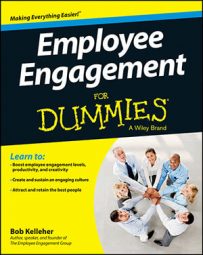Instead of limiting rewards to money, adopt a total rewards strategy that will increase achievement and engagement among your employees. That means expanding your definition of rewards beyond cash. A total rewards strategy may include the following:
Base salary: Yes, this refers to money. Obviously, your employees need to earn a living. Generally speaking, to maintain engagement, you should compensate employees at, slightly above, or slightly below the industry-standard midpoint. If you go too high, you risk your competitive position in the marketplace.
Plus, you may tumble farther than others in an economic downturn because base salaries are not variable. If you go too low, however, you face retention and recruitment issues.
And although money is not an engagement driver with most employees, it can be a disengagement driver if employees in your company become aware that those in similar firms earn more than they do. As for employee benefits, offering the industry standard or slightly better is a good idea.
Incentive compensation: Although market-rate base salaries are good, above–market rate incentive compensation such as bonuses and/or profit sharing increase employee engagement.
Why? Because offering employees a more significant share of the company's overall gains fosters engagement by reinforcing the company's and employee's mutual commitment. Not only does it say, “When we win, we win together,” but it also proves it.
In addition, research shows that firms that cautiously manage their fixed payroll costs (that is, base salaries) while allowing for greater frequency and variability in bonuses and profit sharing can better survive a down year and typically require fewer layoffs. (Over time, layoffs will erode employee engagement, no matter who you are!)
Promotions: Companies with engaged cultures promote from within. Rewarding achievement with stretch assignments and promotions is critical to building a high-performing and engaged workforce. Note, however, that successful companies generally balance internal promotions with external hires, thereby ensuring that the firm brings in new thinking and approaches.
Training and development: Sending deserving employees to offsite training programs, executive education programs, conferences, or seminars should be part of your total rewards strategy.
Training represents a trust-building reciprocal commitment: How can we, as a company, help you, the employee? And how can you, the employee, help us? Training and development opportunities are one of the surest paths to a mutually satisfying outcome.
This is especially true as the Baby Boomers retire and Gen X ascends. Although members of Gen X often suffer from “middle-child syndrome” — they feel caught between two significantly bigger generations (Boomers and Gen Y) — the fact remains that the leaders of tomorrow will emerge from this generation.
Task team or committee involvement: Many organizations populate task teams or committees by selecting volunteers or on an “it's your turn” basis. Employers with an engaged culture, however, populate these teams with their top performers, creating a sort of golden aura over these groups. The result? Employees view their involvement in these groups as a reward for their performance.
Time off: More and more often, employers are offering employees time off in lieu of a paid bonus as a reward for their accomplishments. As work-life balance continues to be a growing theme in the workplace, you'll find that both Generation X and Generation Y often favor time off instead of cash bonuses.
This reward is often a win-win: The employee is glad to have a choice, and the company saves cash. Plus, offering time off is a relatively inexpensive reward, because the vast majority of employees feel a certain obligation to make up the work via discretionary effort.
Flextime: Rewarding top performers with increased flexibility is wise. They've earned the right for the added freedom. Besides, more often than not, they'll respond to this increase in flexibility with higher work output and engagement!
Many employers resist offering flextime for fear that they won't be able to offer it to all employees. But flextime is not an entitlement; it's a reward. If an employee has attendance and/or performance issues, then no, that employee has not earned the right to enjoy flextime.
In addition, some positions simply don't allow for flextime. For example, the office receptionist has to be in the office during set hours — there's just no room for flexibility there.
Consider issuing benefit and reward statements at the end of each year to remind employees how much the organization invested in them. The statement could reflect salary and bonus numbers, health-insurance premiums, time off, tuition reimbursement, and Social Security contributions. Reminding employees of the various benefits and rewards they've received helps reinforce both your mutual commitment and the employer value proposition.

